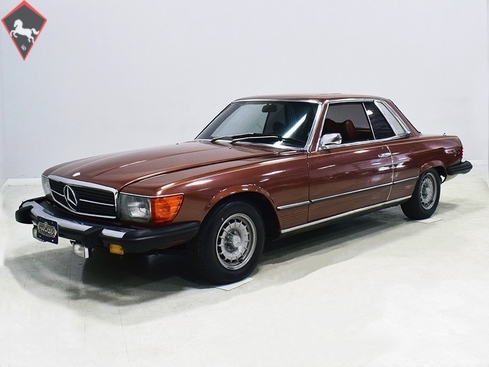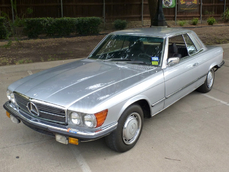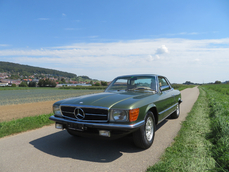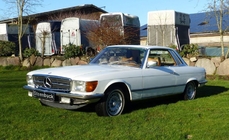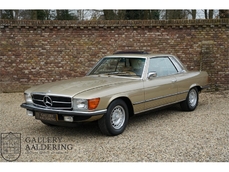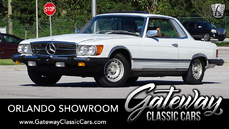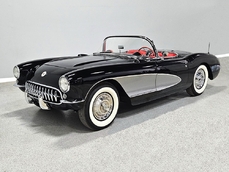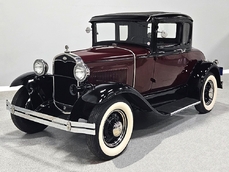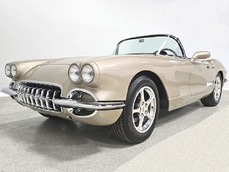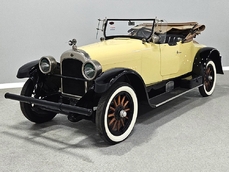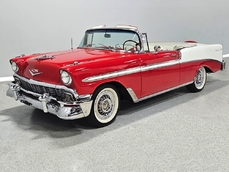Mercedes-Benz 450SLC w107 4.5 liter SOHC V8 1976
General description :
The Mercedes-Benz 450SLC is a car you’ve probably never seen before. Obviously it’s a sibling to the ever-popular range of R107 SL roadsters, and the platform under the SLC is related, called the C107. It offers all the same good stuff: robust build quality, silky smooth and endlessly torquey V8 engine, handsome good looks that still seem contemporary today, plus one thing the SL never offered: a real back seat. The coupe’s longer wheelbase makes for a reasonably usable rear seat area and a more spacious passenger compartment that changes its personality, but only a little. This is a grand tourer in the best sense of the word, able to consume large swaths of pavement at high speeds in comfort. That is what these cars do best. And they’re a real bargain compared to their open-top siblings, too!
I will admit to having a bit of personal bias, as a 450SLC was in our family when I was younger and I spent a lot of hours behind the wheel as a young driver. The car was always competent, reliable, and fun to drive, and the upscale coupe was certainly appealing to a teenager whose peers were driving Chevettes and VW Rabbits. This handsome Topaz Brown 450SLC is simply a good original car that has lived an easy life. It seems to hail from a warm climate that never had to deal with harsh weather, as there’s no notable rust or damage, and like all Mercedes-Benz vehicles of the era, it fits together extremely well. The doors close with a reassuring THUNK and even the metal door handles feel substantial in your hand. The coupe retains the roadster’s overall look, and the added inches are all behind the door, so it gets that cool quarter window treatment and forward-canted C-pillar that make it look sporting. The long hood/short deck styling works especially well, and if you squint a bit, you might even see a bit of muscle car styling in there. With flared fenders, a bulging hood, and a great V8 exhaust note, it could probably be mistaken for a German Mustang. This particular car also features Euro headlights, which are a BIG improvement over the usual four-eyed stare, and the federalized bumpers look right after 5 decades of looking at them.
From behind the wheel, it’s indistinguishable from the SL roadster. Same supportive bucket seats, same big steering wheel, same easy-to-read gauges. We believe the front seats have been reupholstered, but it was done in such a way so to make it simply look like normal age and fading may be in play, so it fits in with the rest of the interior. The MB-Tex in back is a little dry and there’s one split seam, but it isn’t very noticeable and we’d leave it alone. The carpets are surely original, as are the door panels and headliner, all of which are in good condition. The gauges are all operational, the sunroof slides open smoothly, and there’s a newer JVC AM/FM/cassette head unit in the dash, along with what appears to be a microphone for dictation—a relic of the car’s life in the late ’70s. There’s also a CB radio, although we haven’t tried to see if it works. The car was apparently sold and serviced by a Cadillac dealer, which explains the engraved Cadillac nameplate on the dash but we don’t believe the owner was anyone of note. The A/C appears operational but does not blow cold and since it’s an R12 system we have chosen to leave it alone rather than convert it. Even the power antenna goes up and down as it should. The trunk is neatly upholstered with gray carpet, and the original spare tire and jack assembly are included.
Mechanically, the SL and SLC are identical, and in 1976 both were powered by Mercedes’ rugged and wonderfully flexible 4.5 liter SOHC V8. On paper, the 180 horsepower and 220 pounds of torque seem modest, but in the real world this car always feels like it is on the end of a giant recoiling rubber band. That bubbly, smooth, torquey V8 feels like it could pull forever and it never seems to be working very hard. There’s a precise mechanical feel to it that’s also quite appealing—not the isolation to which we’ve become accustomed to today, but rather the feeling of a very expensive piece of machinery doing its thing. There’s a nice V8 burble out back from the recent exhaust system, and thanks to fuel injection, it always starts and idles well. The engine bay is dominated by the giant air cleaner housing and aluminum cam covers, so it should look familiar to anyone who has own a 107-series Mercedes in the past. There are plenty of signs of maintenance throughout and some new components, and the car drives well with no major issues. It’s happy to trundle around town where it dices effortlessly with traffic or blasts down the interstate at supra-legal speeds without breaking a sweat. This is still the Mercedes for people who enjoy driving.
Underneath you can see that this car has never spent time in the harsh snow and salt areas. It isn’t perfect, of course, but the floors, subframes, and rocker panel areas are solid and undamaged. The only notable rust is a finger-sized hole in the battery tray, which shouldn’t be a surprise. The 3-speed automatic transmission was the only option in 1976 and it shifts smoothly and imperceptibly, but offers a quick downshift when you stab the accelerator—this car feels like it’s always on its toes. Out back, the independent rear end carries 3.07 gears, which are tall enough to be quiet and comfortable on the highway but allow the SOHC V8 to get into its sweet spot quickly. The suspension is more luxury than sport, but it’s confident and easy to handle, especially with power steering and brakes being part of the equation. And those brakes are 4-wheel discs that are quite effective. You’ll also note a newer exhaust system, recent fuel pumps, and signs of recent work throughout. Traditional Mercedes-Benz “bundt cake” alloys have been recently refinished and carry 205/70/14 blackwall radials.
These cars have been living under the radar for decades. They’re fast, smooth, competent, and if you have a family, not a bad choice. Add in the legendary durability of the 107 platform, the relative rarity of the body style, and the bargain price, you get a hobby car that’s easy to buy, own, and live with. Or drive it every day—you’ll be thrilled with how modern it feels even 40 years after it was born. Call today!
Harwood Motors always recommends and welcomes personal or professional inspections of any vehicle in our inventory prior to purchase.
http://www.harwoodmotors.com/vehicles/inventory_details.php?id=1213
1976 Mercedes-Benz 450SLC w107 4.5 liter SOHC V8 is listed sold on ClassicDigest in Macedonia by for $9900.
Car Facts
Car type : Car Make : Mercedes-Benz Model : 450SLC w107 Model Version : 4.5 liter SOHC V8 Engine size : 4.5 Model Year : 1976 Location : Ohio
Sold
Seller Information
Sold
People who viewed this Mercedes-Benz 450SLC w107 also viewed similar Mercedes-Benz listed at ClassicDigest
Other cars listed for sale by this dealer
About Mercedes-Benz
In the annals of automotive history, the journey of Mercedes-Benz is a tale that unfolds with the ingenuity of its founding pioneers. In the year 1886, Karl Benz crafted the Benz Patent Motorwagen, a creation that would go down in history as the world's inaugural automobile. Unbeknownst to him, this moment marked the genesis of what would evolve into the most illustrious premium car manufacturer globally. The financial underpinning of this pioneering venture, interestingly, was provided by Karl Benz's wife, Bertha Benz, demonstrating a remarkable partnership that would set the tone for Mercedes-Benz's legacy.A parallel narrative emerged not far away, as Daimler-Motoren-Gesellschaft, founded by Gottlieb Daimler and Wilhelm Maybach, entered the scene. In 1901, they unveiled their automobile under the now-famous moniker "Mercedes," meaning "godsend" in Spanish. This name was bestowed upon the car at the behest of Emil Jellinek's daughter, the distributor for Daimler-Motoren-Gesellschaft. The wheels of innovation were set in motion.
Fast forward to 1926, a pivotal year that witnessed the merger of Daimler with Benz & Cie., culminating in the birth of Daimler-Benz. The amalgamation saw the adoption of "Mercedes-Benz" as the distinguished trademark for their automobiles, fusing the legacies of two visionary entities into one.
Contrary to perceptions of conservatism, the trajectory of Daimler-Benz unfolds as a chronicle of industry firsts. From the introduction of the honeycomb radiator to the float carburetor, and the pioneering implementation of four-wheel brakes in 1924, Daimler-Benz consistently pushed the boundaries of automotive innovation. The diesel-powered Mercedes-Benz 260 D in 1936 marked the inception of diesel engines in passenger cars. The iconic Mercedes-Benz 300SL Gullwing made history as the first car with direct fuel injection, albeit the Gutbrod's tiny 2-stroke engine can claim precedence.
Safety innovations became a hallmark, with Béla Barényi's patented safety cell design in the "Ponton"-models in 1951, featuring front and rear crumple zones. The W116 450SEL 6.9 saw the introduction of the Anti-Lock Brake system (ABS), another pioneering safety feature. From the first production airbags and beyond, the legacy of "firsts" continued to be etched into the fabric of Daimler-Benz.
Over its centennial journey, Mercedes-Benz has not merely produced cars but has sculpted automotive icons. The SSKL, 710 SSK Trossi Roadster, 770K Grosser, 540K Spezial Roadster, 300SL Gullwing, w100 600 Pullman, w111 280SE 3.5 Flachkühler, w113 230SL Pagoda, w109 300 SEL 6.3, and w201 2.3-16 Cosworth stand testament to the brand's commitment to engineering excellence.
The roaring Silver Arrows, or "Silberpfeile," including the W 25, W 125, W154, W165, and W196, created a legacy of dominance on the racetrack. These machines were not merely cars; they were expressions of precision, speed, and an indomitable spirit that left their competitors in the dust.
As Mercedes-Benz marches into the future, it does so not just as an automaker but as a custodian of a legacy, a torchbearer of innovation, and a beacon of automotive excellence. The road ahead is sure to witness the continued fusion of cutting-edge technology, timeless design, and an unwavering commitment to setting new standards in the world of automobiles.
One luminary figure who left an indelible mark was Béla Barényi, often heralded as the "father of passive safety" for his pioneering work in safety engineering. His patented safety cell design, featuring front and rear crumple zones, became a hallmark of Mercedes-Benz's commitment to occupant safety, setting new standards that reverberated throughout the automotive world.
Moving through the chronicles, the collaborative genius of Wilhelm Maybach, alongside Gottlieb Daimler, laid the foundation for Daimler-Motoren-Gesellschaft. Their innovations not only birthed the first Mercedes but established a culture of relentless pursuit of technological excellence that remains integral to Mercedes-Benz's DNA.
In the post-merger era of 1926, Ferdinand Porsche emerged as a prominent figure within Mercedes-Benz. His work on the Mercedes-Benz S-Type, a supercharged race car, garnered acclaim and set the stage for a legacy that extended far beyond the marque. Porsche's impact would later extend to his eponymous company, but his influence at Mercedes-Benz during those formative years was pivotal.
As the 20th century progressed, the legendary Rudolf Uhlenhaut emerged as a key figure. Uhlenhaut, an accomplished engineer and the driving force behind the iconic Silver Arrows, played a crucial role in Mercedes-Benz's dominance in motorsports. His engineering prowess and attention to detail were instrumental in creating some of the most formidable racing cars of the era.
In the latter half of the century, figures like Bruno Sacco, the head of design at Mercedes-Benz from 1975 to 1999, left an indelible imprint on the brand's aesthetic identity. Sacco's design philosophy, characterized by clean lines and timeless elegance, shaped iconic models like the W126 S-Class and the W201 190E, solidifying Mercedes-Benz's reputation for luxury and sophistication.
The narrative would be incomplete without acknowledging the contributions of engineers like Hans Scherenberg, whose leadership in the 1970s ushered in a new era of technological innovation at Mercedes-Benz. Scherenberg's tenure saw the development of groundbreaking technologies, including the Anti-Lock Brake system (ABS) and the introduction of airbags in production cars.
